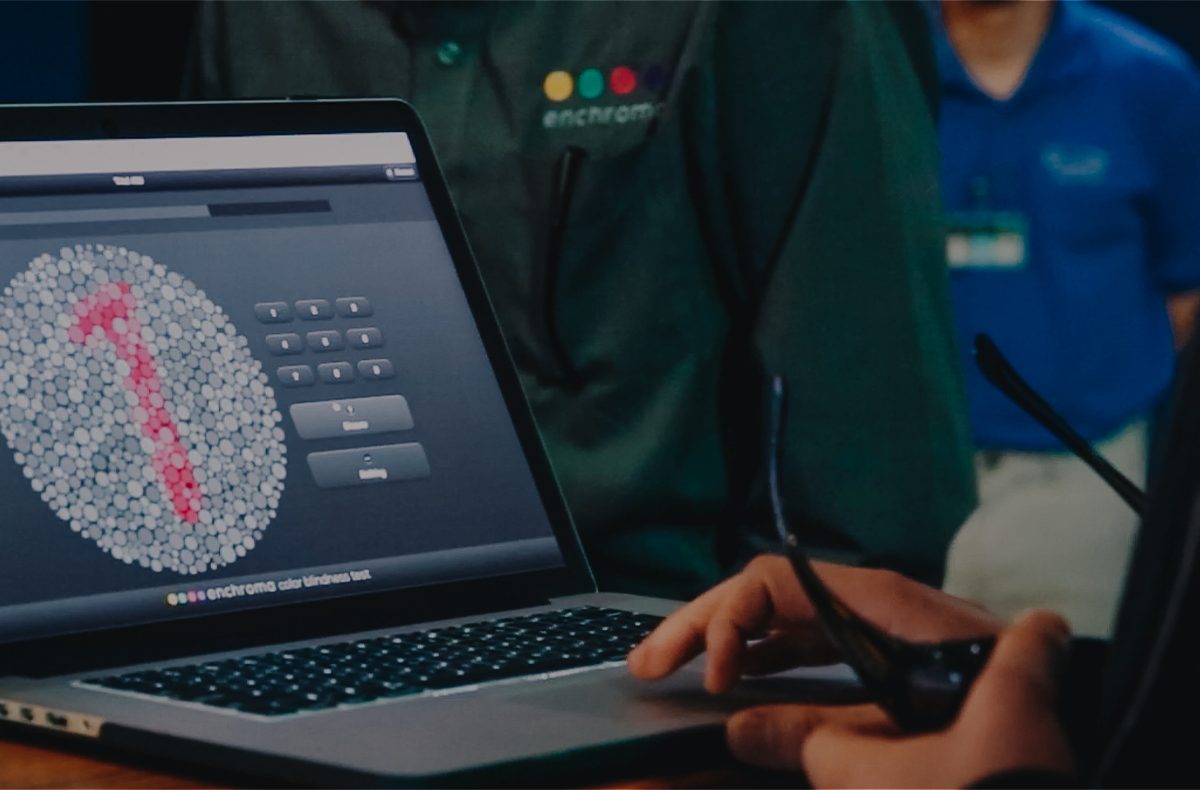Why Can’t I Pass
the Color Blindness Test
with My EnChroma Glasses?
Why Can’t I Pass
the Color Blindness Test
with My EnChroma Glasses?
Why Can’t I Pass
the Color Blindness Test
with My EnChroma Glasses?
Other color blind glasses can help you cheat on the test and might help you pass it. These other color blind glasses that boast an ability to help you pass the test may not deliver on their intended use: to help you see color vibrancy across the color spectrum.
We know it doesn't seem right to buy color blind glasses that make the world so colorfully beautiful but won't also help you pass a simple color blindness test. We hear this often and that makes sense since some have told us that they were devastated as a child the first time they "failed" the color test. We understand your desire to pass the test now that you have your EnChroma glasses, but the Ishihara color blind test is a screening tool designed for one purpose: to screen for all types and extents of color blindness. It is not intended to be used for evaluating performance of color-enhancing or color-correcting filters. In fact, eye care professionals should know that wearing any tinted lens is not allowed when taking an Ishihara color blindness test to assess color blindness.
How Does an Ishihara-type Color Blindness Test Work?
When taking the Ishihara test, the object is to correctly identify the symbol (usually a number) shown within the Ishihara test plate. Test plates are designed using a special random dot pattern, whose colors and sizes create what’s called Luminance-Contrast Noise. The resulting pattern of colors camouflage any color brightness differences (Luminance Contrast) that might help the color blind detect and identify the number. That means that to read the symbol hidden in the plate, you are forced to use only your perception of color. Additionally, the colors used to camouflage brightness are highly desaturated colors. That makes it difficult to distinguish between the colors, enabling only those with normal or typical color vision to see the hidden symbol and pass the test. And, because of how the color sensitivities are shifted in the color blind (see our blog: What Do Color Blind People See?), these desaturated colors confuse the color blind, and make numbers in the Ishihara test invisible. Ishihara is a good test because desaturated colors confuse people in real life. For instance, pink, light green and grey are more or less identical to the color blind.
The Test Through an EnChroma Lens
Now let’s talk about trying the test with EnChroma glasses. EnChroma lenses provide very special wavelength-selective filtering to improve color saturation (the intensity of the color). This is effective for moderately saturated colors, but not for highly desaturated or strongly saturated colors. Simply put, EnChroma glasses will not have much of an effect on the desaturated colors that make up the Ishihara test. Since the Ishihara test plate creates the camouflage that hides the numbers using desaturated colors, you won’t see the numbers in the test with EnChroma glasses. You can, however, see an improved real world of color. Our glasses also specially absorb yellow colors. Again, since yellow has little effect on desaturated colors, this important characteristic of seeing color in the real world will provide little help in the case of trying to read the number in an Ishihara test plate correctly. This is also true for strongly saturated colors. Additionally, our glasses work best in context i.e., comparing colors together. For example, a pink flower in sunlight against green foliage will be more noticeably pink, whereas the same pink in a plate test, as a few small dots, will be less visible or prominent to the colorblind.
Fooling or Cheating on the Test
The test, whether online or paper does require certain lighting conditions. For example, the paper test requires a bright white light i.e., lighting made up equally of all colors. It’s easy to mistakenly use room lighting that adds more blue, or more yellow to what you see. Also, you are not allowed to wear any type of glasses with a colored filter lens because they can help you cheat on the test. EnChroma color blind glasses enhance blue, green, and red colors equally, and do not provide obvious luminance cues (i.e. distorted brightness) that might result in a false positive result when taking a color blindness test. Color blindness glasses don't work in the same way that prescription glasses help you see the eye chart. That’s why it seems counterintuitive that a pair of glasses designed to improve color perception won’t help to see the colors of a color blindness test.
EnChroma glasses are designed to provide those with color vision deficiency the profound joy to be had by seeing so many improved colors that the world has to offer. They are not designed to help pass a color blind test. Just put on your EnChroma glasses and enjoy all the color the world has to offer. No test required.
Why Do Other “Color Blind” Glasses Tell You They Can Help Pass the Test?
Other color blind glasses use the test to appeal to your desire to finally pass that darn test. The problem is that the way they work doesn’t help you see color, instead they only alter the brightness of the colors of the dots. The glasses help make the background darker and the number or symbol brighter, or vice versa. That reveals the number. For example - here’s how it works.
A red color lens will make the desaturated colors olive, blue-green, and
teal dots darker while brightening the pinks of the number “2”.
Other color blind glasses can help you cheat on the test and might help you pass it. These other color blind glasses that boast an ability to help you pass the test may not deliver on their intended use: to help you see color vibrancy across the color spectrum.
About the EnChroma Color Blind Test
The Ishihara test was first invented at the turn of the last century, it is claimed, as a result of a horrific train accident and the inability to see the train signals. That means that it has been an important safety screening test for more than a century. Today Ishihara-type tests can be taken many different ways. A modern version, the EnChroma Online Color Blind Test uses the familiar number images. It is quick and easy and can be taken on any computer or smartphone screen. The EnChroma test looks the same but is different behind the scenes in the way that it uses your answers. The test can reveal your type and extent of color blindness, tell if you have normal color vision as well as when you’re trying to fool the test. The original Ishihara test was painted, then printed on paper cards, often made into a book of plates. The plates feature the exact same pattern types as the online version of the test.
We know it doesn't seem right to buy color blind glasses that make the world so colorfully beautiful but won't also help you pass a simple color blindness test. We hear this often and that makes sense since some have told us that they were devastated as a child the first time they "failed" the color test. We understand your desire to pass the test now that you have your EnChroma glasses, but the Ishihara color blind test is a screening tool designed for one purpose: to screen for all types and extents of color blindness. It is not intended to be used for evaluating performance of color-enhancing or color-correcting filters. In fact, eye care professionals should know that wearing any tinted lens is not allowed when taking an Ishihara color blindness test to assess color blindness.
Other color blind glasses can help you cheat on the test and might help you pass it. These other color blind glasses that boast an ability to help you pass the test may not deliver on their intended use: to help you see color vibrancy across the color spectrum.
How Does an Ishihara-type Color Blindness Test Work?
When taking the Ishihara test, the object is to correctly identify the symbol (usually a number) shown within the Ishihara test plate. Test plates are designed using a special random dot pattern, whose colors and sizes create what’s called Luminance-Contrast Noise. The resulting pattern of colors camouflage any color brightness differences (Luminance Contrast) that might help the color blind detect and identify the number. That means that to read the symbol hidden in the plate, you are forced to use only your perception of color. Additionally, the colors used to camouflage brightness are highly desaturated colors. That makes it difficult to distinguish between the colors, enabling only those with normal or typical color vision to see the hidden symbol and pass the test. And, because of how the color sensitivities are shifted in the color blind (see our blog: What Do Color Blind People See), these desaturated colors confuse the color blind, and make numbers in the Ishihara test invisible. Ishihara is a good test because desaturated colors confuse people in real life. For instance, pink, light green and grey are more or less identical to the color blind.
The Test Through an EnChroma Lens
Now let’s talk about trying the test with EnChroma glasses. EnChroma lenses provide very special wavelength-selective filtering to improve color saturation (the intensity of the color). This is effective for moderately saturated colors, but not for highly desaturated or strongly saturated colors. Simply put, EnChroma glasses will not have much of an effect on the desaturated colors that make up the Ishihara test. Since the Ishihara test plate creates the camouflage that hides the numbers using desaturated colors, you won’t see the numbers in the test with EnChroma glasses. You can, however, see an improved real world of color.
Our glasses also specially absorb yellow colors. Again, since yellow has little effect on desaturated colors, this important characteristic of seeing color in the real world will provide little help in the case of trying to read the number in an Ishihara test plate correctly. This is also true for strongly saturated colors. Additionally, our glasses work best in context i.e., comparing colors together. For example, a pink flower in sunlight against green foliage will be more noticeably pink, whereas the same pink in a plate test, as a few small dots, will be less visible or prominent to the colorblind.
Fooling or Cheating on the Test
The test, whether online or paper does require certain lighting conditions. For example, the paper test requires a bright white light i.e., lighting made up equally of all colors. It’s easy to mistakenly use room lighting that adds more blue, or more yellow to what you see. Also, you are not allowed to wear any type of glasses with a colored filter lens because they can help you cheat on the test. EnChroma color blind glasses enhance blue, green, and red colors equally, and do not provide obvious luminance cues (i.e. distorted brightness) that might result in a false positive result when taking a color blindness test. Color blindness glasses don't work in the same way that prescription glasses help you see the eye chart. That’s why it seems counterintuitive that a pair of glasses designed to improve color perception won’t help to see the colors of a color blindness test.
EnChroma glasses are designed to provide those with color vision deficiency the profound joy to be had by seeing so many improved colors that the world has to offer. They are not designed to help pass a color blind test. Just put on your EnChroma glasses and enjoy all the color the world has to offer. No test required.
Why Do Other “Color Blind” Glasses Tell You They Can Help Pass the Test?
Other color blind glasses use the test to appeal to your desire to finally pass that darn test. The problem is that the way they work doesn’t help you see color, instead they only alter the brightness of the colors of the dots. The glasses help make the background darker and the number or symbol brighter, or vice versa. That reveals the number. For example - here’s how it works.
A red color lens will make the desaturated colors olive, blue-green, and teal dots darker while brightening the pinks of the number “2”.
Other color blind glasses can help you cheat on the test and might help you pass it. These other color blind glasses that boast an ability to help you pass the test may not deliver on their intended use: to help you see color vibrancy across the color spectrum.
About the EnChroma Color Blind Test
The Ishihara test was first invented at the turn of the last century, it is claimed, as a result of a horrific train accident and the inability to see the train signals. That means that it has been an important safety screening test for more than a century. Today Ishihara-type tests can be taken many different ways. A modern version, the EnChroma Online Color Blind Test uses the familiar number images. It is quick and easy and can be taken on any computer or smartphone screen. The EnChroma test looks the same but is different behind the scenes in the way that it uses your answers. The test can reveal your type and extent of color blindness, tell if you have normal color vision as well as when you’re trying to fool the test. The original Ishihara test was painted, then printed on paper cards, often made into a book of plates. The plates feature the exact same pattern types as the online version of the test.



